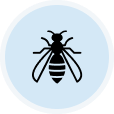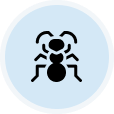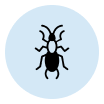Maybe you noticed a few bed bug bites or blood stains, or maybe you caught one of those little apple-seed-sized trespassers in the act.
Perhaps after finding the evidence, you thought, “Well, there’s a difference between a few bed bugs and a full-blown infestation. Maybe this isn’t cause for concern.”
Well, we’re here to tell you: It definitely is cause for concern.
A few bed bugs do mean that you have a complete infestation, or at least that you will shortly. Any signs of bed bugs mean that you should contact a professional exterminator as soon as you can.
Bed bugs reproduce very quickly, and they are also great at hiding. So if you saw some bed bugs, that means there are more stowed away in secret hiding places. And if the infestation gets out of hand, then you might have to throw away all your furniture, clothes, carpets, and more, which, of course, we want to avoid.
Do not try to handle a bed bug infestation on your own! If you identify any bed bugs, contact a pest control company immediately.
Let’s go over how you could have gotten bed bugs and how to get rid of them effectively.
Key Takeaways
- Common signs of bed bugs include itchy bug bites, small spots of blood on your sheets, tiny blackish spots in hidden crevices near your bed, little white eggs, discarded exoskeletons, or small, visible, brownish/ reddish bugs about the size of a lentil.
- Bed bugs spread very easily and can come from hotel rooms, taxis, daycares, planes, nursing homes, and more.
- You can search for bed bugs in the seams of your mattress, cracks in the headboards and baseboard, under your couch cushions, and more.
- Bed bugs reproduce quickly, so if you find any signs of an infestation, you should call your local pest control immediately.
 1st pest control service just $49
1st pest control service just $49
Must schedule service online.
Act now. Limited time offer.
Bed Bug Introductions
If you’re scratching your head (and armpits and neck and face… sorry) and wondering where these bed bugs came from, there are a few potential culprits.
Just know that bed bugs don’t discriminate. Having bed bugs doesn’t mean that your home was dirty or that you got them from an unclean source. Bed bugs can come from a fancy hotel, a daycare, a popular tourist attraction, and more.
What Are Bed Bugs?
Bed bugs are small insects that come out at night, find you by sniffing out the carbon dioxide you exhale, and bite you to consume human blood.
While bed bug bites don’t typically cause health problems, if you are allergic to the bugs, then you could have an allergic reaction characterized by swelling around the bites and, in rare cases, anaphylaxis. If you have an allergic reaction that causes your throat and tongue to swell, then that is a medical emergency, and you should call 911.
Another rare scenario to be aware of is that the bug bites could also become infected from excessive scratching. But, in most cases, the worst effect is sleep loss from the overwhelming itching.
Overall, bed bugs are no joke, they are tough to get rid of, and the best case scenario is avoiding them in the first place.
How Do Bed Bug Introductions Occur?
Bed bugs are expert stowaways, and they could have come from a hotel, a taxi, a dorm room, an office, a gym, a plane, or even just from placing your backpack on the ground or the wrong chair.
How to Identify a Bed Bug Introduction
The initial signs of bed bugs can be difficult to spot and sometimes even invisible to the naked eye. The initial bed bug sightings might come from the following sources:
- A musty odor
- Tiny specks of blood
- Bed bug exoskeletons
- Tiny, white, oval eggs
- Little blackish specks of bed bug excrement
How to Prevent a Bed Bug Introduction
Bed bugs are extremely difficult to get rid of once they’ve been introduced to your home. That’s why it’s best to avoid getting bed bugs in the first place.
Try these steps to check for bed bugs on your things:
If you’re staying in a hotel room…
- Don’t unpack immediately upon arrival or set your luggage on the bed.
- Check the bedding and mattress for bed bug eggs, bed bug fecal matter, or reddish-brown bugs about the size of an apple seed. Bed bugs also shed skins that they can leave out in the open that look similar to a dead bug.
If you bought used furniture…
- Check all crevices and inseams carefully for the same signs as above: fecal matter, eggs, exoskeletons, and the bugs themselves.
After traveling…
- Especially if you travel frequently, consider keeping your used clothes in a plastic bag inside your suitcase.
- Quarantine your suitcase upon arriving home by leaving it outside before vacuuming the inside and outside and inspecting for bed bug eggs, live bed bugs, or other hitchhikers.
- Wash all the clothes, bags, etc., that you traveled with in hot water.
Check out this article for more advice on how to avoid catching bed bugs when traveling.
Bed Bug Infestations
Once the bugs are introduced, they typically get to reproducing quickly. There are small things you can do to mitigate this, but truthfully, as soon as you find the first bug, it’s best to call an exterminator.
How Do Bed Bug Infestations Occur?
Sometimes bed bugs become so prevalent that homeowners are forced to throw away all their furniture, clothes, bedding, and carpets! These infestations happen if the bugs are not identified and cleaned out early on.
Signs of an Infestation
Some of the most common signs of an infestation include:
- Small, itchy bite marks on your skin– These bites are raised and purplish on darker skin tones and red on lighter skin tones. They usually appear in groups and on parts of your skin that are exposed when you sleep, like your face and neck.
- Small spots of human blood on your bed sheets– These come from the bites or from rolling over and squishing a bed bug at night that was still full from its last blood meal.
- Pepperings of brownish spots- Bed bug feces and eggs usually appear along the mattress seams or corners of mattresses in a peppering of dark spots.
How to Search for Bed Bugs
To conduct a thorough bed bug search, here are a few places you might not think to look:
- In the seams, tags, and piping of your mattress
- Couches, beneath cushions and in the seams
- Cracks in the bed frame and headboard
- Pillowcases
- Loose wallpaper
- Electrical outlets
- Baseboards
- Carpets
- In the folds of curtains
- Underneath framed photos or wall hangings
- In drawers on the tracks and joints
 1st pest control service just $49
1st pest control service just $49
Must schedule service online.
Act now. Limited time offer.
Steps to Take If You Have a Bed Bug Infestation
If you’ve already identified some signs of bed bugs and you want to prevent an overwhelming infestation, then you should contact your local pest management ASAP.
But if you want to lessen your bed bug problem while you wait for the full extermination treatment, there are a few things you can do.
- Clean up the room and throw away unneeded trash to take away hiding places.
- Vacuum the places where you expect they may be camping out.
- Wash and dry linens and pillowcases in very hot water (above 120ºF) or use hot steam on the infected areas.
- For things that can’t be exposed to too much heat, try leaving them in the freezer.
- Purchase encasements for your mattress and box spring.
- If you are a landlord or own multiple properties and got word of a bed bug infestation in your building, then bug-sniffing dogs can come in to identify any bugs that could be hard to find otherwise.
- If the infestation is severe, then you might need widespread fumigation or other chemical treatments like pesticides and insecticides.
- Call a professional. The above steps can help calm an infestation, but remember that bed bugs can survive in many places, even deeply hidden areas like behind wallpaper and underneath carpets, so it’s always best to contact your local bed bug control to make sure everything is completely cleared out. For more details about pricing, read “What’s the Cost of Bed Bug Extermination.”
For high-quality pest control, get in touch with Simple Pest Management. Our Bed Bugs Program uses a two-step treatment plan; first, to kill the bugs, then we use an agent that prevents the bugs from reproducing more.
To prepare for your bed bug extermination appointment, run all your clothes through the dryer and secure them in tightly sealed Ziploc bags. Then, wash and dry all your bedding and pillowcases at high heat and prop your mattress and bedframe up against the wall. Remove all items in your bedroom (closet, wardrobe, nightstand, etc.), put them in plastic bags, and store them far from the room that will be treated for the bugs.
And don’t worry! We’ll get rid of those pesky little vampires in no time. For a free consultation, call us at (619) 373-7378 (PEST).







 You’re supporting a small, local business
You’re supporting a small, local business


